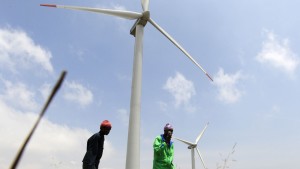 When the Lake Turkana Wind Farm opens in 2017—worth nearly $1 billion and boasting 365 wind turbines that will help generate approximately 15% of Kenya’s power—it will have the financial backing of Google.
When the Lake Turkana Wind Farm opens in 2017—worth nearly $1 billion and boasting 365 wind turbines that will help generate approximately 15% of Kenya’s power—it will have the financial backing of Google.
On Oct. 20, the company announced that it will be acquiring a 12.5% stake in Africa’s largest wind-power project by purchasing a stake held by Vestas, a Danish manufacturer and installer of wind turbines. This Google’s second renewable energy investment in Africa, after it invested $12 million in the Jasper solar project in South Africa two years ago.
The investment Google and other investors are making in the wind-power project—dubbed as the largest single private investment in Kenya’s history—will help reduce the country’s reliance on hydro and thermal as the two main sources of energy. The country is already diversifying its energy mix, raising wind power from 0.3% of its output in 2013 to 9.4% in 2017.
Having spent $2 billion in renewable energy on 22 investments, including a $300 million investment in Solar City, the solar energy company co-founded by Elon Musk‚ Google’s investments in energy are on the rise. But there’s another added advantage for Google to invest in clean energy in Africa.
Writing in Fortune, Katie Fahrenbacher argues that by investing in clean renewables, Google is helping solve one of the challenges it encounters in developing countries like Kenya. “As many developed countries have brought almost their entire populations online, Google is keen to help connect the future of its Internet users who lack access to the Internet. The major resource that drives an Internet connection is an energy source,” she says